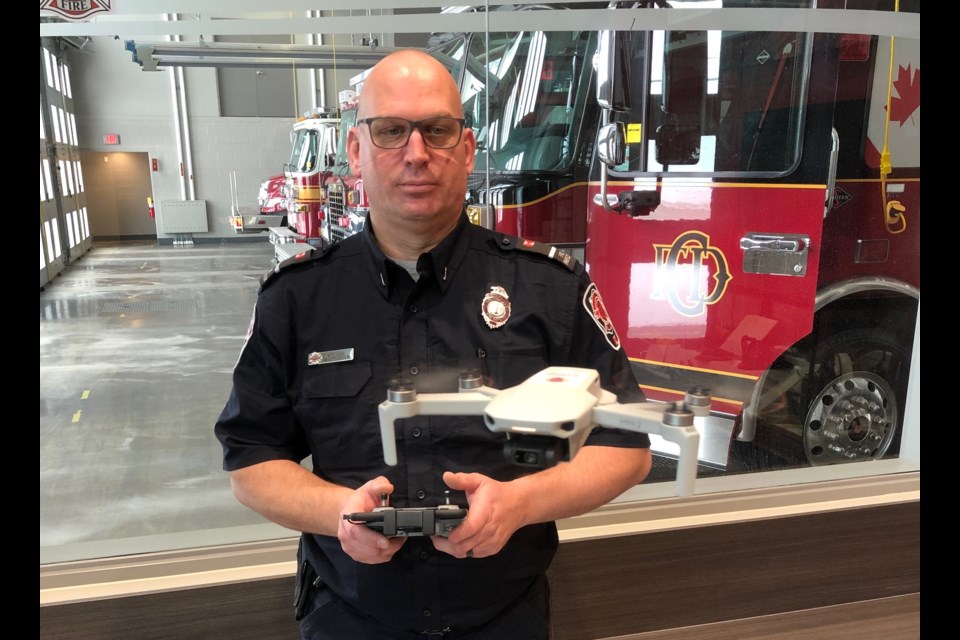Blog entry by Bruce McPherson

One of the latest recruits to the Collingwood Fire Department can fly over tall buildings, but it’s not a plane or a bird.
The fire prevention staff have added a 249-gram quadcopter drone to their truck to assist with rooftop inspections.
Fire Prevention Inspector Jeff Gage said he uses the drone to reach hard-to-access rooftops for commercial inspections.
Used for outdoor portions of the inspections only, the drone can survey a roof top and get in close for photos of any ventilation or units mounted on the roof. Before the DJI Mini drone became part of the fire department tool box, that would have to be done manually by a person on the ceiling.
Gage said he would sometimes have to ask the fire suppression crew to bring a ladder truck to the site so he could get on the roof for an inspection.
“The biggest thing for us is the health and safety implications,” said Gage. “Not having to access rooftops [in-person] is a plus. Anytime we don’t do that, it’s safer.”
With less dependence on the availability of a ladder truck, which could be called away to a fire, Gage can do more inspections and on his own schedule.
He said it’s a very useful tool for smaller fire departments.
“With few human resources to draw on, if one person can do an entire job safely, that’s the route to go,” he said.
There may be times when photos from the drone will show some red flags requiring an in-person inspection, but the drone photos will also give a more clear picture of what is on top of a roof before Gage or other fire prevention staff have to go up there.
“This helps us understand what’s going on, and rooftops we wouldn’t be able to access normally, we’ll be able to look at,” said Gage.
Outside of rooftop inspections, Gage said they used the drone to pinpoint the location of suspicious barrels dumped in a field. Photos from the drone also help the fire crews identify any materials contained in the barrels.
The tech is readily available in publicly accessible drones. The exact drone can be purchased at Best Buy for about $800. Gage said the drone has already paid for itself because of saving time and resources for the department.
The drone is controlled via smartphone. Gage can put his phone into the controller adapter, plan a route, and send the drone on its way.
The drone is a fairweather tool only, but that works for inspections, which are not emergency situations.
The prevention drone technically makes a fleet for the Collingwood Fire Department, since they have one other drone that’s been in use since late 2019.
The first drone came to the fire department after a rather dramatic rescue of a deer on an ice flow off the shore of Sunset Point.
The concerned citizen who called in the deer in distress was moved by the Collingwood Fire Department’s work to rescue it (with help from The Blue Mountains Fire Department and their Zodiac boat). The citizen made a donation to the Collingwood Fire Department toward a rescue boat of their own as well as for a drone and the training required for each member of the fire department to get licenced to fly it.
Used for the suppression and rescue side of the fire department’s work, the first drone, a Mavic 2 Enterprise, is equipped with an infra-red camera, a regular camera, and attachments such as a spotlight and speaker that can play a recorded message.
The larger of the two drones is also tougher, and can be sent up to capture aerial shots during a structure fire.
Photos from above a fire can help the crew get more information about what’s going on and get a more complete 360 view of the situation.
After the fire is under control, the thermal imaging camera can be used to locate hot spots that have potential to flare up again.
Fast spreading grass fires can be hard for firefighters to size up from the ground. A drone can zoom into the air above it to capture a photo of its spread.
“Start to finish it helps,” said Deputy Fire Chief Dan Thurman. “It’s another tool in the toolbox, another option to help fight the situation.”
Beyond fighting fires, Thurman said the Mavic drone can be used on almost any call.
In a search and rescue situation, fire crews can record a message to let someone know help is on the way and they should stay put. The message can be played through the drone’s speaker as it speeds through a forest trail, or along the ice over Georgian Bay.
Thermal imaging from the infrared camera can also allow the fire department to more quickly locate a person who is stranded on a trail or in the water.
For a hazardous materials call, the drone can be sent in to get photos of any warning labels or spills to give firefighters a better indication of what materials are involved in a spill or fire. They can stand a safe distance away while the drone sends back high-resolution photographs.
The Mavic and all its accessories cost about $3,500 plus the certification (about $1,000 per person).
As a self-proclaimed tech nerd, Gage said he’s excited about the future of drone technology applied to fire suppression, rescue and prevention.
“The technology coming is incredible,” said Gage. “There are drones that will leave the station and fly ahead of the fire truck to the call.”
In the meantime, he’ll be bringing the mini drone to his commercial inspections and keeping up to date on the latest applications for drone tech in the fire prevention field.
By Erika Engel , Collingwood Today